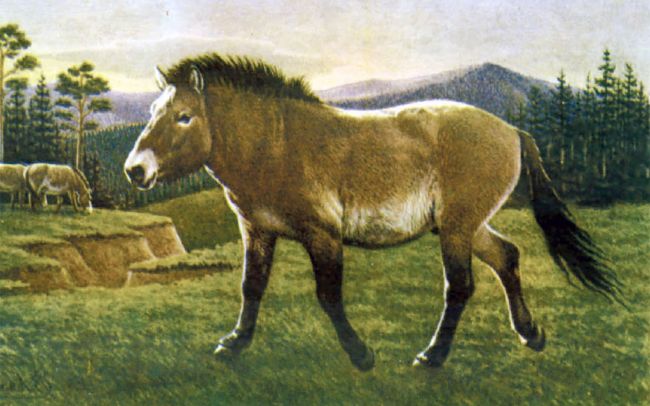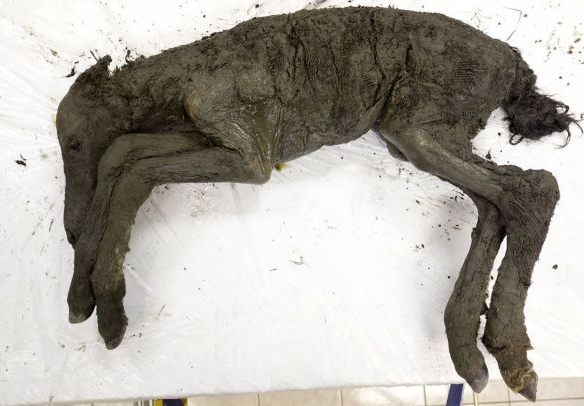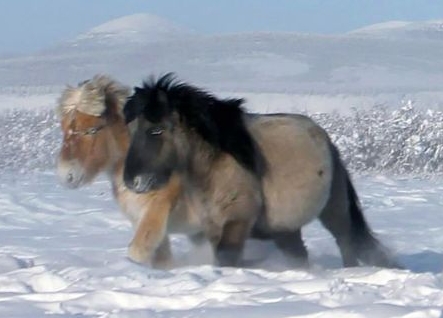|
The origin of the Yakut breed of horses by Professor Ivanov Revoriy Vasilievich
|
|
An astonishing discovery was made in 2019 inside the Batagaika crater in Yakutia, when scientists found a perfectly-preserved foal mummy that was 40,000 years old.
(Scroll down for English)
Происхождение лошадей якутской породы
Иванов Р.В. ЯНИИСХ
Аннотация
Произведен краткий обзор по происхождению лошадей якутской породы. Многие исследователи придерживаются гипотезы о присутствии у лошадей якутсой породы крови диких лошадей севера . Существует и противоположное мнение о том, что предки якутов освоили территорию Якутии на лошадях. Нужен особый методический подход для дальнейших исследований возможного автохтонного присутствия в происхождении лошадей якутской породы.
Ключевые слова: Обзор , происхождение ,якутская лошадь.
Summary
In this study a brief review of the origin of the horses of the Yakut breed is made. Many researchers stick to the hypothesis that Yakut horses come from ancient crossbreed wild horses of the north. There is an opposite opinion that the ancestors of the Yakut people claimed the territory of Yakutia on horseback. A special methodological approach is needed for further studies of the possible autochthonous presence in the origin of horses of the Yakut breed.
The origin of the Yakut breed horses has long been of interest to researchers. The head of the first scientific expedition to study horse breeding in Yakutia, M.I Rogalevich (1941) put forward a hypothesis that the northern types of horses of the Yakut breed have the blood of wild horses: “The certainty that this wild horse is still alive or not long ago was roaming and asserting its influence on the domesticated horses of the North, is confirmed by the fact that in the direction from Yana to the east to Kolyma, that is, just to those places pointed out by Antonius, the horse seems to be larger… This question, without doubt, must be resolved through further research of the horse breeding of Yakutia.”
M.F.Gabyshev, referring to the works of the first researchers-explorers of Yakutia A.F. Middendorf (1862), I.D. Chersky (1885), V.A. Seroshevsky (1896), put forward a hypothesis about the deep antiquity of horse breeding by the aboriginals, settled in the northern territory of Yakutia prior to the arrival of the Yakut people. I.D. Chersky (1890, cited by M.F. Gabyshev, 1957) considered it indisputably established that wild horses, which are contemporaries of the mammoth, lived far within the outskirts of the Arctic Circle, downstream of the river Yana and on the Novosibirsk Islands.
Based on a detailed comparative - anatomical analysis of the size and morphological structure of each skeleton bone of the late Pleistocene and modern horses of Yakutia, P.A. Lazarev (1980) concluded that the modern Yakut horse is identical in all its skeletal and exterior features to the late Pleistocene horse. Based on this he proposes that this horse did not become extinct like the mammoth, woolly rhino and other mammals, but became part of the modern fauna of Yakutia and continues to exist in the form of the modern Yakut horse.
 |
Frozen in ice for millennia, the Siberian foal is the best-preserved ancient horse ever found. The two-month-old Ice Age horse even had perfectly preserved hair.
|
I.P. Guryev (1990) first
studied the immunogenetic
and craniological characteristics of the ecotypes of Yakut horses in comparison
with the
Kazakh horses of the Jabe type and
Mongolian horses. This
established significant genetic differences between the ecotypes of Yakut horses
in
polymorphic serum proteins, erythrocyte antigens and
the
allele
genes that control them. It
showed a high genetic similarity
between the
Yakut horses of the central
offspring with southern steppe horses and the genetic distance
that the horses of the
Verkhoyansk and Kolyma types
have from them. Then I.P.
Guryev
came to the following conclusion: “Despite the existence at the edge of the
range, the Kolyma population turned out to be the most heterozygous and
polymorphic, which is probably due to its formation from two (or three) small
groups that do not coincide in genetic structure .. . ”.
This conclusion of I.P. Guryev, in our opinion, quite convincingly affirms the origin of the horses of the Kolyma type from their wild ancestors and the horses on which the Yakuts first arrived in the Kolyma lowlands. This is probably why the Kolyma horses are much larger in their dimensions than the indigenous horses.
Meanwhile, N.D. Alekseev (2001), on the basis of many years of research on the study of the morphophysiological and biochemical mechanisms of adaptation of horses to the extreme conditions of the North, considers the opinion of all the above authors about the possible blood introduction of a wild tundra horse to modern horses, on which the Yakuts claimed the territories of the floodplains of northern riversYana, Indigirka and the Kolyma lowlands, to be erroneous..
N.D. Alekseev substantiates his statement by the fact that, in his opinion, the physiological capabilities of the organism of the horse in general and of the Yakut horse, in particular, are much higher than the response to the impact of environmental conditions. The main parameters of the horse's functional life support system in the winter period, compared to summer period, significantly increase: the volume of blood circulation per minute increases by 59%, the volume of circulating blood - by 23%, erythrocytes - by 71.6%. And the blood flow rate by 19%. At the same time, despite the increase in the functional activity of some systems in the winter period, adaptation to the cold of winter occurs mainly in the mode of saving energy costs for maintenance of life. This is achieved both by improving the thermal insulation of the coat, and by reducing the functional activity of some body systems (reducing respiratory volume, decreased respiratory movements, decreased oxygen consumption, etc.).
N.D. Alekseev confirms his conclusion by the successful acclimatization in the conditions of Central Yakutia of the Jabe stallions bred in the semi-desert zone of Kazakhstan.
Three stallions aged five years were brought from Kazakhstan (Vinokurov I.N., 1988). They were used as breeding stallions for three years. The resulting crossbred offspring in live weight, slaughter yield, yield of technical raw materials, offal and morphological composition of the carcass did not differ from their Yakut peers
Due to the fact that outstanding animals were not obtained from them in terms of produce and, especially, adaptive qualities, these animals were not used in the future in breeding work and at present their offspring have not been preserved.
Librado P., et al. (2015) sequenced and analyzed the complete genomes of nine modern horses and two horses excavatedin the Eveno-Bytantai district. Comparing the genomes of these horses with the genomes of two late Pleistocene, twenty-seven domesticated and three wild Przewalski horses, the authors came to the conclusion that modern Yakut horses do not descend from local horses that inhabited the region until the middle of the Holocene. In Eveno – Bytantai district, they were crossbred by the ancestors of the Yakuts, who first settled these territories on horses of southern origin. The authors consider the unique adaptive features of the Yakut horse to be one of the fastest cases of adaptation to extreme temperatures in the Arctic.
However, samples were taken from only nine horses and only in Eveno – Bytantai district. In our opinion, it was necessary to take samples from at least 30 horses, and, most importantly, in several northern districts: Verkhoyansk, Abyisk and Kolymsk. Moreover, even in one district, samples should be taken from several settlements, because, as we assume, wild horses lived scattered and in small numbers. By the time of the settlement of these territories by the Yakuts, perhaps only along the estuaries of the Yana, Indigirka and Kolyma. Therefore, there were initially few hybrids, just as few as the horses with a distant presence of blood now.
In this regard, horses in the Abyisky district of the republic represent scientific interest. Here in 2016 snow fell one and a half meters deep. Of the stock of horses available at the beginning of winter, only 30% survived, this is a little over 600 heads. It seems to us that among these remaining, the most hardy and unpretentious horses, we must look for the descendants of the wild horses of the North.
This allows us to put forward an incredible, at first glance, but with good reason, proposal that before the arrival of the Yakuts in Abyy, there were already people there engaged in hunting, fishing and horse breeding.
| These horses, cousins to the foal that died so long ago, currently make their home in Yakutia. |
|
Many scientists (S.A. Tokarev, 1941, A.N.Bernstein, 1947, A.N. Alekseev, 1994,1996) came to the conclusion about the possible participation of the autochthonous population of Yakutia in the ethnogenesis of the Sakha people.
Ushnisky (2014) carried out an analysis of scientific research on the history of the origin of the Sakha people and came to the conclusion about the synthesized origin of the Yakut ethnos - the fusion of southern newcomers with local autochthonous groups.
The historical information of M.I. Starostina (2002) about the first waves of settlement of the Abyisky district by equestrian people is interesting. The first two routes were carried out by the Verkhoyansk and Oymyakon Yakuts through the Momsky district. The third route, according to the author, was also carried out on horseback from the shores of the Arctic Ocean. M.I Starostina writes: “The third route of the Yakuts to Indigirka passed along the coast of the Arctic Ocean. Since ancient times, the Yakuts lived on the territory of Bulun, Ust-Yana, from where they moved to Indigirka and Alazeya. ... It is known that since ancient times they kept horses, reindeer, dogs, were engaged in hunting and fishing. "
Some Yakuts, representatives of the northern districts, have an opinion (self-identification) - “Биhи хотугу сахалар”, which means “We are the northern Yakuts”. Indeed, they are quite different in appearance from representatives of other districts. In the same way, we, experts, can easily distinguish between horses of the Kolyma and Yansk types. But among them there are horses with even more pronounced aboriginal signs of the exterior, first of all, the barrel-shaped body (eirisomnost). It was eirisomism, characteristic compactness, the predominance of a light-mousey coat with a belt on the back that distinguished the individuals we examined from those remaining 630 heads of Abyy horses.
| An artist’s impression of the Ice Age horse. |
 |
Therefore, despite the seemingly indisputable data of Librado P., et al. (2015), we have the opinion that with a certain improvement in the methodological approaches and research sites, there is a need to continue the search for the autochthonous presence in the origin of the Yakut horses.
Images appear courtesy of Michil Yakovlev/SVFU/The Siberian Times.
Список литературы:
1. Рогалевич М.И. Коневодство Якутской АССР.М.1941.-76с.
2 . Габышев М.Ф. Якутская лошадь.Якутск .1957.- 239с.
3. Лазарев П.А. Антропогеновые лошадиЯкутии .Наука . М.- 190с.
4. Гурьев И.П. Иммуногенетические и краниологические особенности экотипов якутской лошади . Автореферат канд. дисс. 1990.- 21с.
5. Алексеев Н.Д. О происхождении лошадей якутской породы (биологические аспекты). /Сб.науч.тр.ЯНИИСХ СО РАСХН. Роль сельскохозяйственной науки в стабилизации и развитии агропромышленного производства Крайнего Севера. С.192 – 195.
6. Винокуров И.Н. Эффективность скрещивания казахских жеребцов типа джабе с матками якутской породы . Авторефератканд.дисс.1988. – 26с.
7. Librado P., etal. Tracking the origins of Yakutian horses and the genetic basis for their fast adaptation to subarctic environments. PNAS\Published online November 23,2015.\E6889-E6897.
8. Токарев, С. А. Происхождение якутской народности // Краткие сообщения
о докладах и полевых исследованиях Института истории материальной культуры АН
СССР. Т. 9. М.; Л.1941 С. 58–69.
9. Бернштам, А. Н. Заметки по этногенезу Северной Азии // Советская
графия.1947. С. 61–63.
10. Алексеев, А. Н. Древняя Якутия. Железный век и эпоха Средневековья.Сер. : История и культура Востока Азии.
11. Алексеев, А. Н. К вопросу о происхождении якутского народа // Сборник науч. тр. Серия: Филология. Якутск: Изд-во ЯГУ.1994. С. 66–67
12. Старостина М.И. История заселения и освоения бассейна Индигирки якутами в конце 18 – начале 20 веков Автореф.дисс.канд. ист .наук 2002.- 11с.
List of references:
1. Rogalevich M.I. Horse breeding of the Yakut ASSR, Moscow, 1941.-76s.
2. Gabyshev M.F. Yakut horse. Yakutsk. 1957 - 239 p.
3. Lazarev P.A. Anthropogenic horses of Yakutia. The science . M. - 190s.
4. Guriev I.P. Immunogenetic and craniological features of the Yakut horse ecotypes. Abstract of Cand. dissertation. 1990.- 21s.
5. Alekseev N.D. About the origin of the horses of the Yakut breed (biological aspects). / Collection of scientific works YANIISKH WITH EXPANSION The role of agricultural science in the stabilization and development of agro-industrial production in the Far North. Pp. 192 - 195.
6. Vinokurov I.N. Efficiency of crossing of Kazakh stallions of the Jabe type with the uterus of the Yakut breed. Abstract of Candidate Dissertation, 1988. - 26p.
7. Librado P., et al. Tracking the origins of Yakutian horses and the genetic basis for their fast adaptation to subarctic environments .PNAS \ Published online November 23, 2015. \ E6889-E6897.
8. Tokarev, S. A. The origin of the Yakut people // Brief messages
on reports and field research of the Institute of the History of Material Culture of the Academy of Sciences
THE USSR. T. 9.M .; L.1941 S. 58–69.
9. Bernshtam, A. N. Notes on the ethnogenesis of North Asia // Soviet
graphy. 1947. S. 61–63.
10. Alekseev, A. N. Ancient Yakutia. The Iron Age and the Middle Ages, Ser.: History and Culture of the East of Asia.
11. Alekseev, AN On the question of the origin of the Yakut people // Collection of scientific. tr. Series: Philology. Yakutsk: YSU Publishing House. 1994. P. 66–67
12. Starostina M.I. The history of the settlement and development of the Indigirka basin by the Yakuts in the late 18th - early 20th centuries Author's abstract of thesis. Historical Sciences 2002.- 11p.


